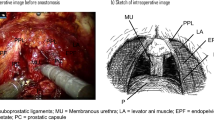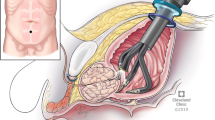Abstract
High local stage prostate and bladder cancers frequently require wide local resection and sacrifice of one or both cavernous nerves to achieve a negative surgical margin, thus resulting in erectile dysfunction. This is a report on preliminary experience with cavernous nerve graft reconstruction using sural nerve grafts with radical prostatectomy or radical cystectomy.
Pre-operative evaluation was performed and consent was obtained in 14 potent men with prostate (11) or bladder (three) cancer. Sural nerve grafts of resected cavernous nerves were performed using a microsurgical technique. Post-operative treatment (Sildenafil or Alprostadil) was pursued until return of spontaneous function, documented by interview and adequate scores (>20) in the erectile function (EF) domain of the International Index of Erectile Function (IIEF).
Twelve unilateral nerve grafts were performed, 10 during radical prostatectomy and two during radical cystoprostatectomy. Two procedures were technically not possible because of locally advanced disease. Mean age was 57.5 y (36–68 y). Mean follow up was 16.1 months (7–28 months). Pathological stage of prostate cancer was pT2 in 2, pT3 in 7 and pT4 in one. Surgical margins were positive in five out of 10 (50%), and two (20%%) had positive lymph nodes. Four patients (three post prostatectomy and one post cystectomy) were fully potent. Additionally, one patient post prostatectomy had improving partial erections. Six patients post prostatectomy and one patient post cystectomy had no erections. The only complication was one superficial wound infection in the sural nerve donor site.
Preliminary experience shows that sural nerve grafts are feasible and safe after radical prostatectomy and cystectomy. However, candidates usually present with high stage disease, high risk for recurrence and frequent requirement for adjuvant therapy that further compromises erectile function. Randomized studies with more patients and long follow-up periods are necessary in order to define the ideal candidate for nerve graft procedures.
This is a preview of subscription content, access via your institution
Access options
Subscribe to this journal
Receive 4 print issues and online access
$259.00 per year
only $64.75 per issue
Buy this article
- Purchase on Springer Link
- Instant access to full article PDF
Prices may be subject to local taxes which are calculated during checkout

Similar content being viewed by others
References
Davidson PJ, van den Ouden D, Schroeder FH . Radical prostatectomy: prospective assessment of mortality and morbidity. Eur Urol 1996; 29: 168–173.
Lowentritt BH, et al. Sildenafil citrate after radical retropubic prostatectomy. J Urol 1999; 162: 1614–1617.
Quinlan DM, Epstein JI, Carter BS, Walsh PC . Sexual function following radical prostatectomy: influence of preservation of neurovascular bundles. J Urol 1991; 145: 998–1002.
Kim ED, et al. Interposition sural nerve grafting during radical retropubic prostatectomy. Urology 2001; 57: 211–216.
Quinlan DM, Nelson RJ, Walsh PC . Cavernous nerve grafts restore erectile function in denervated rats. J Urol 1991; 145: 380–383.
Burgers JK, Nelson RJ, Quinlan DM, Walsh PC . Nerve growth factor, nerve grafts and amniotic membrane grafts restore erectile function in rats. J Urol 1991; 146: 463–468.
Walsh PC . Nerve grafts are rarely necessary and are unlikely to improve sexual function in men undergoing anatomic radical prostatectomy. Urology 2001; 57: 1020–1024.
Kim ED, et al. Interposition of sural nerve restores function of cavernous nerves resected during radical prostatectomy. J Urol 1999; 161: 188–192.
Scardino PT, Kim ED . Rationale for and results of nerve grafting during radical prostatectomym. Urology 2001; 57: 1016–1019.
Kadmon D, et al. Unilateral interposition sural nerve grafting following ipsilateral neurovascular bundle resection at radical prostatectomy (RP) decreases the time to potency recovery. J Urol 2001; 165 (no. 5, Suppl) 149.
McKiernan JM, et al. Cavernous nerve graft reconstruction following radical prostatectomy in 77 patients: feasibility, safety and early results. J Urol 2001; 165 (no. 5, Suppl) 149.
Rosen RC, et al. The international index of erectile function (IIEF): a multidimensional scale for assessment of erectile dysfunction. Urology 1997; 49: 822–830.
Klotz L . Neurostimulation during radical prostatectomy: improving nerve-sparing techniques. Sem Urol Oncol 2000; 18: 46–50.
Sobin LH, Wittekind C (eds)TNM Classification of Malignant Tumors: International Union Against Cancer. 5th edn. Wiley-Liss: New York. 1997. pp. 170–173.
Feng MI, et al. Effect of sildenafil citrate on post-radical prostatectomy erectile dysfunction. J Urol 2000; 164: 1935–1938.
Montorsi F, et al. Recovery of spontaneous erectile function after nerve-sparing radical retropubic prostatectomy with and without early intracavernous injections of alprostadil: results of a prospective, randomized trial. J Urol 1997; 158: 1408–1410.
MacKinnon SE, Dellon AL . Nerve injury and regeneration. In: MacKinnon SE, and Dellon AL (eds). Surgery of the peripheral nerve Thieme Medical: New York. 1988. pp. 16–34.
Sunderland S . Nerve grafting and related methods of nerve repair. In: Sunderland S (ed.). Nerve injuries and their repair: a critical appraisal Churchill Livingstone: Edinburgh. 1991. pp. 467–497.
Kury P, Stoll G, Muller HW . Molecular mechanisms of cellular interactions in peripheral nerve regeneration. Curr Opin Neurol 2001; 14: 635–639.
Battiston B, et al. Nerve repair by means of vein filled with muscle grafts I. Clinical results. Microsurgery 2000; 20: 32–36.
Ball RA, et al. Entubulization repair of severed cavernous nerves in the rat resulting in return of erectile function. J Urol 1992; 148: 211–215.
Kim ED, et al. Bilateral nerve graft during radical retropubic prostatectomy: 1-year follow up. J Urol 2001; 165: 1950–1956.
Author information
Authors and Affiliations
Corresponding author
Rights and permissions
About this article
Cite this article
Anastasiadis, A., Benson, M., Rosenwasser, M. et al. Cavernous nerve graft reconstruction during radical prostatectomy or radical cystectomy: safe and technically feasible. Prostate Cancer Prostatic Dis 6, 56–60 (2003). https://doi.org/10.1038/sj.pcan.4500613
Received:
Revised:
Accepted:
Published:
Issue Date:
DOI: https://doi.org/10.1038/sj.pcan.4500613
Keywords
This article is cited by
-
The genitofemoral and ilioinguinal nerves as neurorrhaphy candidates for erectile function restoration in patients with prostatectomy-induced erectile dysfunction
European Journal of Plastic Surgery (2022)
-
Sexual dysfunction after pelvic surgery
International Journal of Impotence Research (2006)
-
Effects of Chronic Bacterial Prostatitis on Prostate Specific Antigen Levels Total and Free in Patients with Benign Prostatic Hyperplasia and Prostate Cancer
International Urology and Nephrology (2006)



